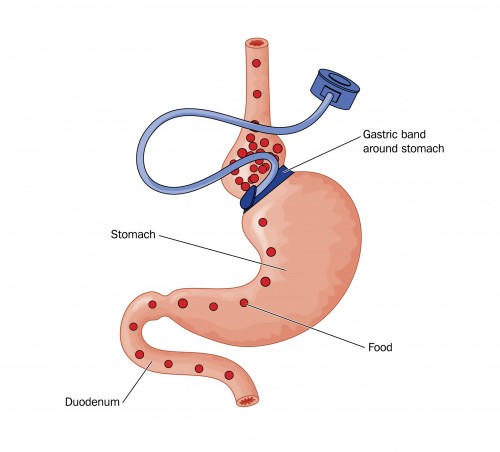Adjustable Gastric Band – Facts, Risks & Costs
What if there was a surgical procedure that promised to help you lose weight and was also completely adjustable and totally reversible?  Of course there is such a thing, and it’s called Laparoscopic Gastric Banding (“gastric banding” for us lay people without medical degrees). You may have heard it being called “lap band surgery” or “gastric band surgery”. These are all the terms for the same thing. The Lap Band is actually a trademarked name for the device manufactured by Allergan Inc. but people use it generically, kind of like “Panadol”.
Of course there is such a thing, and it’s called Laparoscopic Gastric Banding (“gastric banding” for us lay people without medical degrees). You may have heard it being called “lap band surgery” or “gastric band surgery”. These are all the terms for the same thing. The Lap Band is actually a trademarked name for the device manufactured by Allergan Inc. but people use it generically, kind of like “Panadol”.
The Allure of Gastric Banding
Lap band surgery has several features that make it attractive to morbidly obese people considering weight loss surgery. Of course there are other methods out there, but given the choice, gastric banding is normally the first choice among surgery candidates.
Why People Think They Want Gastric Banding
Simple, because it’s a surgical procedure that’s less invasive than its counterparts, that’s the one everyone wants. We’ll take a look at how and why in just a moment. But first, you’ll want to hear about the other reasons people think they prefer gastric banding over other methods of bariatric surgery…
Adjustable
The method of decreasing your stomach size is adjustable, which is wonderful news because it means your doctor can dial it up or tone it down, according to your particular needs and your body. He or she can also easily control the side effects by adjusting the ring on your stomach.
Reversible
The ring or “band” used in lap band surgery can be removed by a doctor at any time.
Safer
Because gastric banding is minimally invasive, it’s also safer. Recovery goes better, too.
No Malnutrition
Unlike gastric bypass surgery, Laparoscopic gastric banding has nothing to do with food absorption. It simply makes your stomach smaller so you can’t eat as much. Food that does get eaten is readily absorbed by your small intestine, no problem. In gastric bypass surgery, on the other hand, parts of your digestive system which is responsible for absorbing nutrients are actually removed from your body, often causing vitamin deficiencies.
I’m In! Now How Does Lap Band Surgery Work?
Remember we told you the main reason people prefer lap band surgery was that it’s minimally invasive? Here’s what that means. The incisions a surgeon makes in your stomach are tiny because all he or she needs to fit in there are tiny tools and a small silicone ring.
Think of this ring as a “belt”…you know how cinching a belt around your waist might make it uncomfortable to eat, or do anything? It’s essentially the same thing…the silicone ring goes around the top of your stomach, where the food comes in. The ring is connected to a tube and at the other end of the tube is an access port, which will be accessible to your doctor.
This is where he or she pumps saline into the silicone ring to inflate it or deflate the inner band, thus controlling the diameter of the ring. It can be adjusted to allow more or less food into your stomach, depending on your needs. Only a small amount of food can now fit in your stomach, so you feel full faster and stop eating pretty soon after you’ve started.
The band also serves to slow down movement of food from the stomach to the small intestine. This tricks your brain into thinking it’s full, also causing you to stop eating after just a few bites.
Here’s A Video Of How The Process Works
BUT…Whoa, Not So Fast… All this sounds pretty good- the case for gastric banding seems pretty strong, right? Hold your horses, because we’re not done yet. If you’re thinking about gastric band surgery, then you should also know that despite all those wonderful “pros” you just read about, it’s quickly falling out of favour in the medical community. Studies are finding that long-term benefits are not so great with the gastric banding method because in most cases, they gain back the weight they lost.
One of the main contributing factor is not the failure of the method itself, rather, it’s the eating habit that goes unchanged. That’s disappointing to hear, but it should be understood that many people who choose lap band surgery eventually go on to have gastric bypass surgery for more permanent results. Others had to have repeat gastric banding performed.
So, while gastric band surgery might look great at first glance, no surgery is optimal if it has to be repeated a few years down the line. That’s not the only reason lap band surgery is falling out of favour. Here are a few more to consider:
- Band slippage. The band can slip out of place at any time. There’s another surgery for you, to put it back in place.
- Infection. The port where the doctor pumps in saline can become infected. This will require antibiotics at best, another surgery at worst.
- Port problems. Your saline port may become inaccessible to the doctor. Also, your port can get flipped upside down. Sometimes needles can puncture your tube. Another surgery to fix any of these.
These problems are real and they are not rare. Therefore, before you get too gung-ho on the benefits of laparoscopic surgery, carefully consider all of these risk factors. The lower cost suddenly melts away when you have to have repeat surgeries, as does the lower risk.
As For The Cost…
Please check the prices over here
